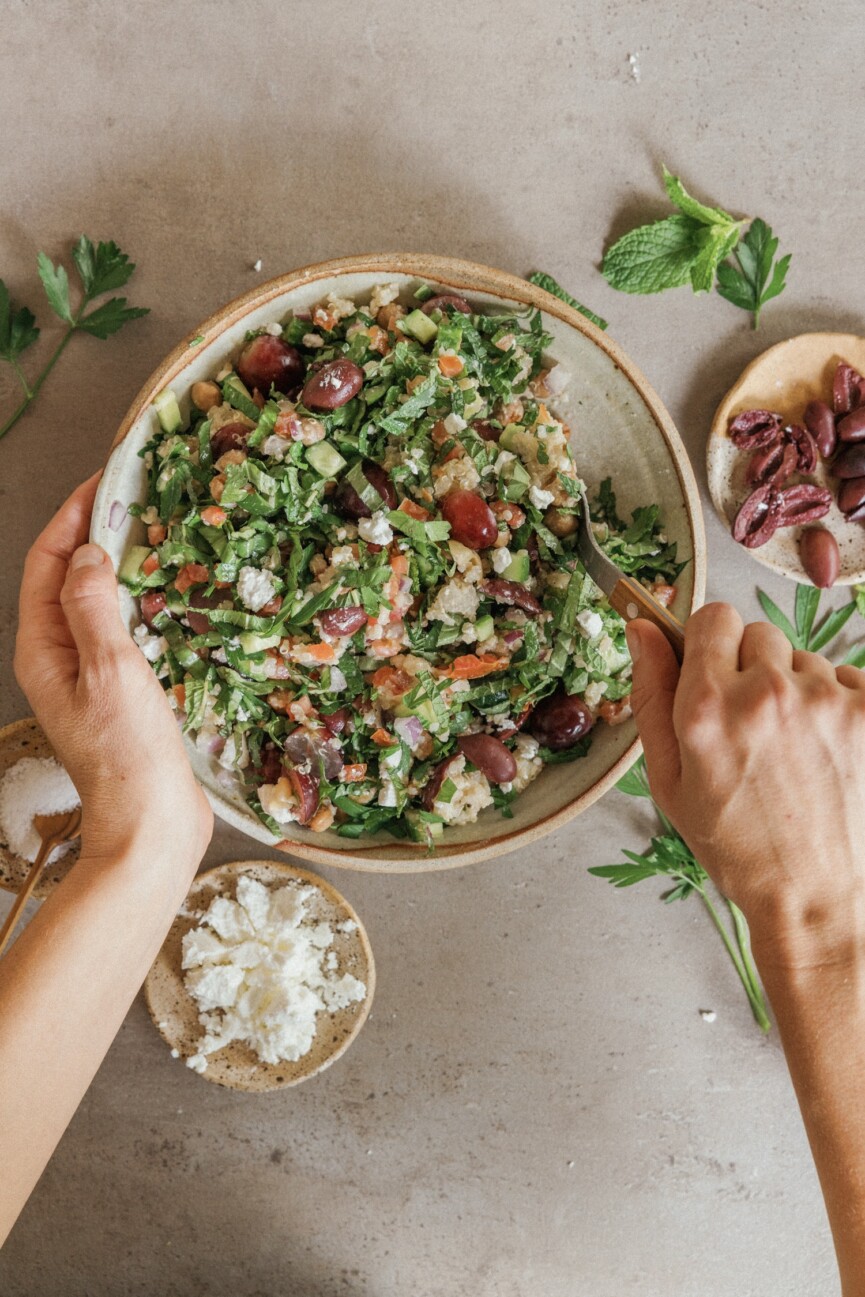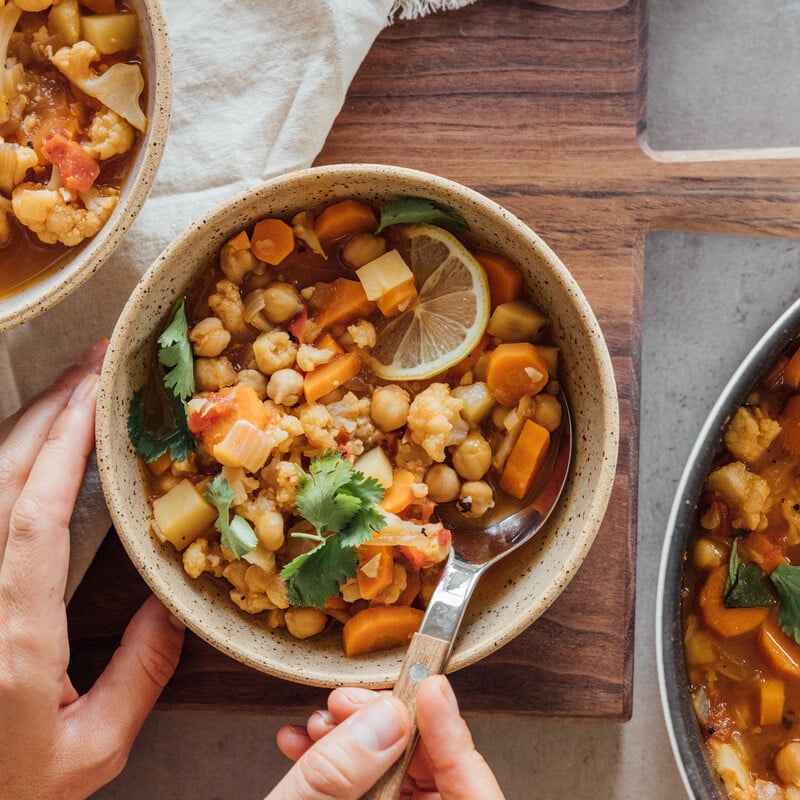It comes as no surprise that food can make or break your health goals. Food is medicine. In many ways, improved digestion, and sustained energy could be a well-stocked fridge away. But most people overlook a simple yet powerful phenomenon: food combining. It could be a total game-changer.
Taking a sustainable approach, there’s no need to eliminate key food groups (like carbohydrates) to be well. Rather, if you’re looking to boost your health, particularly your blood sugar levels, consider the order in which you eat your food. It can be just as important as what’s on your plate. Similar to food combining, eating order isn’t new. In fact, the principles first appeared in early Ayurvedic medicine. Is it worth the hype? Let’s dig in.
Featured image by Michelle Nash.


What is food combining?
Complexities aside, here’s the gist of food combining: Food combining is a style of eating that endorses certain food combinations. The notion is based on the claims that foods digest at different rates, have varying transit times in our gastrointestinal tract, and require specific pH environments. For example, proteins need an acidic environment to be broken down, whereas carbohydrates need an alkaline environment.
Despite its popularity, there is no evidence to support the previous claims. However, that doesn’t mean that certain aspects of food combining are off the table. The way you combine foods can be relevant. For instance, there are evidence-based food combinations that can significantly improve or reduce the digestion and absorption of certain foods. Examples include adding foods rich in vitamin C with foods rich in iron to increase iron absorption.
The Hay Diet
Wondering how food combining became popular? As mentioned, food combining principles aren’t new. They were popularized in the mid-1800s, under the term “trophology” or “the science of food combining.” Eventually, these principles were revived by Dr. Hay—the father of the Hay diet. Popular in the 1930s, the Hay diet is based on the idea that you should avoid combining certain foods. The reason being that certain combinations hinder digestion and can increase levels of acidity in the body.
As far as the Hay diet is concerned, all foods fall into one of three categories: Alkaline, acidic, and neutral. Alkaline foods are carbohydrate-rich, such as rice, grains, and potatoes. Acidic foods are protein-rich (dairy, meat, etc.). Neutral foods include fats, like nuts, and leafy greens. It also emphasizes that fruit is best on an empty stomach for breakfast.
Is there scientific evidence to support food combining?
Over time, Dr. Hay’s diet has inspired a cult following of health enthusiasts. Although there is no scientific evidence to support the health benefits of food combining, the anecdotal evidence speaks for itself. Despite the lack of scientific evidence, you may notice an improvement in your digestion, energy, and cognitive function. Given that we’re all bio-individuals, we all digest and assimilate nutrients differently. So don’t knock it until you try it—food combining might be worth a try.
Common Food Combining Rules
Proponents of food combining suggest the consumption of protein with carbs (fruit and starches) can cause gas, bloating, and poor digestion, and in turn, result in poor nutrient absorption. Based on these theories, food-combining diets recommend consuming certain foods on their own or in specific combinations for potentially improved digestion.
Do’s:
1. Eat fruit on an empty stomach.
2. Pair non-starchy vegetables (leafy greens) with protein, fat, or carbs.
3. Wait 3-4 hours between meals before switching categories.
Don’ts:
1. Consume starches and protein at the same meal/together.
2. Consume fats and protein at the same meal/together.
3. Combine starches with acidic foods.
4. Combine different types of protein.
5. Eat fruits and vegetables at the same time.
6. Drink liquids with meals.

In what order should I eat my food?
As you can see, food combining has a variety of rules (more extensive than the list above!). Eating order, on the other hand, is much simpler. It’s less about food combinations and more about the order in which you eat. Ideally, you want to start your meal with vegetables and protein, and finish with carbohydrates. Studies show this can keep you fuller, longer than if you ate the same foods in the reverse order and it can aid in blood sugar regulation.
To get even more specific, consider having a savory meal rather than sweet for breakfast. For example, pasture-raised eggs and organic veggies cooked in ghee. For lunch and dinner, try to begin with veggies (leafy greens, broccoli, etc.) and fat (avocado, nuts, olive oil, etc.). You’ll automatically increase your veggie intake, thus increasing your micronutrients. For your entree, nosh on protein before starchy carbs. Save the best for last: dessert. When eating starchy carbs as a snack, like a banana, pair it with a source of protein (string cheese), fat (almond butter), or fiber (chia seeds) to control post-meal glucose.
Benefits of Eating Order
In essence, this is because protein slows down the release of sugar from carbohydrates into the bloodstream. This prevents a sugar spike, then crash (blood sugar dysregulation). In fact, doctors say this manner of eating is most significant for diabetics. Eating protein and vegetables before carbohydrates leads to lower post-meal glucose and insulin levels in obese patients with type 2 diabetes. This finding could impact the way clinicians advise diabetic patients (and other high-risk individuals) to eat. Rather than focus on how much to eat, the emphasis is on when carbohydrates are consumed.
Other studies show the same. When protein is consumed before starchy carbohydrates, controlling glucose is easier. In turn, it can help maintain weight. Timing carb consumption could positively impact blood glucose levels, supporting your overall health goals.
Incompatible Food Combinations, According to Ayurveda
Through Ayurveda, an ancient holistic science of healing, you can take a logical approach to food combinations. Ayurveda believes that understanding yourself as an individual is the key to finding a truly balanced diet. That said, here are some (general) incompatible food combinations. Keep in mind that it may be possible for you personally to combine these foods without digestive issues.
- Don’t eat beans with fruit, dairy, eggs, fish, or meat.
- Don’t eat eggs with fruit.
- Don’t eat fruit with any other food.
- Don’t eat grains with fruit or tapioca.
- Don’t drink hot drinks with mangos, starches, fish, meat, or dairy.
- Don’t eat nightshades (potato, tomato, etc.) with melon, cucumber, or dairy.
- Don’t eat radishes with banana, raisins, or milk.
Last but not least, according to ancient Ayurvedic literature, honey should never be cooked. Instead, use a sweetener like a maple syrup, when baking.
Symptoms of Poor Digestion
The gut microbiome is incredibly complex. Symptoms of poor digestion can include:
- An upset stomach. Think gas, bloating, indigestion, constipation, etc.
- Intense sugar cravings. A diet high in processed foods and added sugars can decrease the amount of good bacteria in your gut.
- Inflammation. While poor digestion can lead to inflammation, inflammation also leads to poor digestion. It’s a vicious cycle.
- Eczema. Skin conditions, like eczema, can be related to a damaged gut.
- Constant fatigue. An unhealthy gut may contribute to sleep disturbances, like insomnia or poor sleep. The majority of the body’s serotonin, a hormone that affects mood and sleep, is produced in the gut. So gut damage can impair your ability to sleep well.
- Unintentional weight fluctuations. Gaining or losing weight without making changes to your diet or exercise habits may be a sign of an unhealthy gut. An imbalanced gut can impair your body’s ability to absorb nutrients.
Useful Tips to Avoid Indigestion and Bloating, According to Ayurveda
When it comes to aiding in digestion and avoiding bloating, consider the following Ayurvedic tips:
- Eat 1/2 teaspoon freshly grated ginger with a pinch of rock salt before each meal
- Alkaline foods (fruits, vegetables, etc.) help digestion and regulate gastric fire
- Ghee stimulates our digestion and metabolism, thus improving digestion
- Proper chewing is essential as it ensures food gets thoroughly mixed with saliva
- Small sips of warm water during a meal will aid in digestion and absorption of food
- Enjoy a short walk after your meal
4 Recipes for Food Combining
When it comes to recipes for food combining, keep it simple. By streamlining your meals, the digestive system doesn’t have to tackle too much in one sitting, helping you to avoid that bloated, sluggish feeling that can put a damper on the rest of your day.
Salmon Roll Sushi Bowl
An easy, protein- and veggie-packed solution for your weekday lunch. This sushi bowl is bursting with flavor and is full of satiating ingredients.
Big Green Immunity-Boosting Vegetable Soup
Get all the greens while enjoying a deliciously creamy soup. Blending in soaked cashews lends your soup a whole lotta rich flavor while still keeping it vegan. The ingredients list may initially seem long, but this recipe couldn’t be easier.
Slow Cooker Chicken Burrito Bowls
These chicken burrito bowls are an easy one-pot meal in the slow cooker. With a four-ingredient filling and endless ideas for assembling your bowls, this dish is a healthy weeknight wonder. Rich in fiber, protein, and healthy fats, combine grains and beans for a satisfying lunch or dinner.
Vegetable Drawer Goat Cheese Frittata
This one-pan breakfast is full of fiber-rich veggies and satiating protein. Perfect for meal prep for the week, this dish is vegetarian and gluten-free.
This post was last updated on April 20, 2025 to include new insights.





